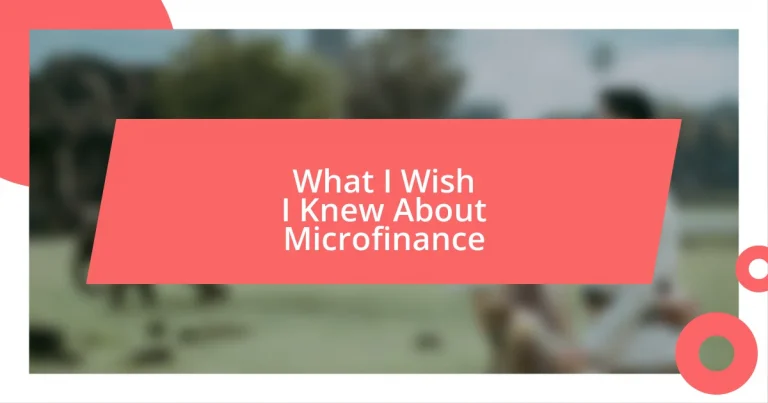Key takeaways:
- Microfinance encompasses more than small loans, offering services like savings, insurance, and financial education to promote financial inclusion and empower underserved communities.
- Common misconceptions include that microloans always lead to debt and are only for women; in reality, with proper support, both men and women can benefit successfully from microfinance.
- Future trends in microfinance include technology-driven solutions for accessibility, a focus on social impact metrics, and the integration of ESG principles to promote sustainable practices.
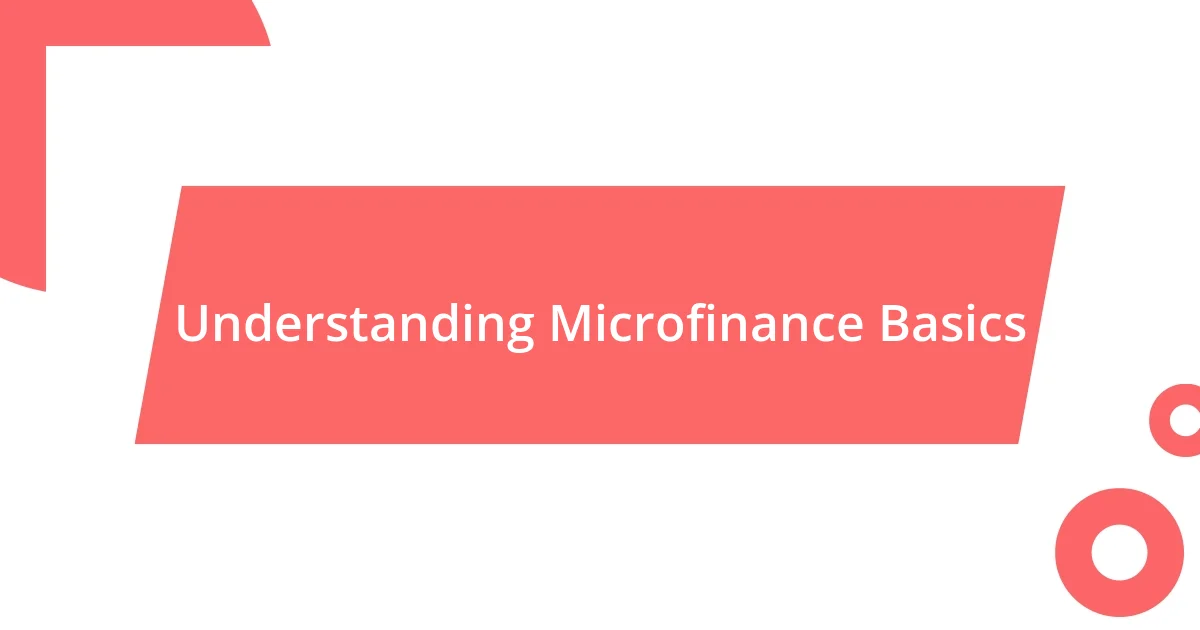
Understanding Microfinance Basics
Microfinance is often misunderstood as merely providing small loans. In my experience, it’s much more than that. It encompasses a range of financial services, including savings accounts, insurance, and financial education, all tailored to empower underserved communities. Have you ever thought about how a small amount of money can change someone’s life?
I remember meeting a woman named Maria in a small village during my travels. She took out a microloan to start a weaving business. The joy in her eyes as she recounted her journey of financial independence was priceless. This personal touch is essential to grasp the fundamentals of microfinance; it’s about building a supportive ecosystem where individuals can thrive, not just get by.
At its core, microfinance aims to foster financial inclusion, providing opportunities to those who usually get left behind by traditional banks. It invites us to consider, what would our communities look like if everyone had access to these resources? These questions challenge us to envision a world where financial barriers are dismantled, allowing dreams like Maria’s to become reality for many others.
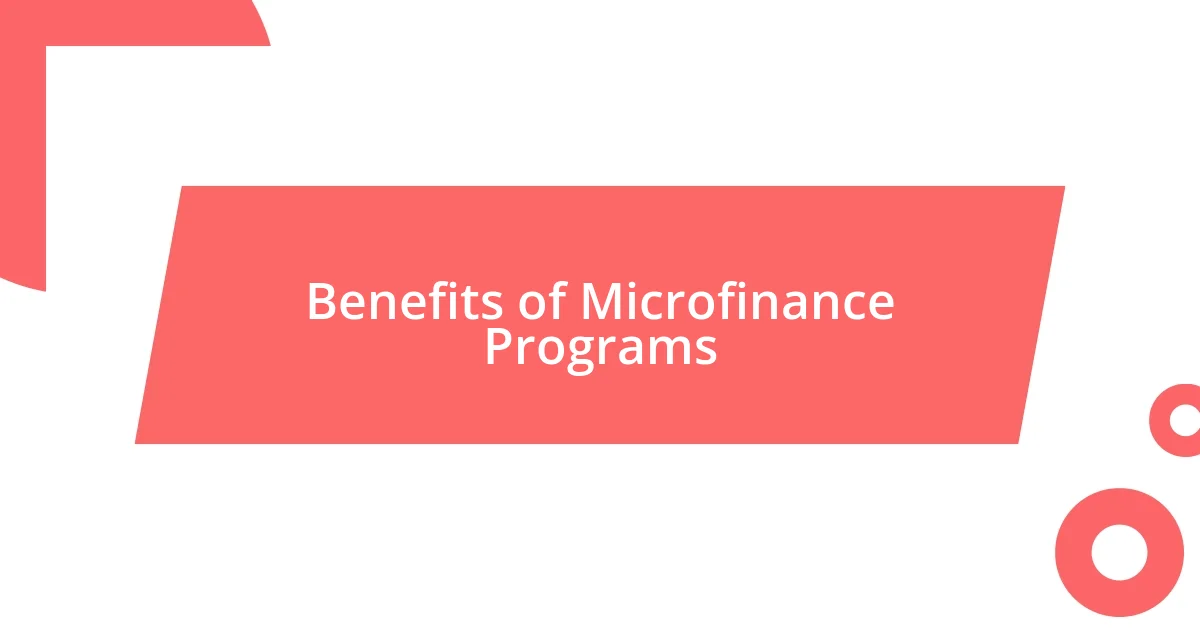
Benefits of Microfinance Programs
Microfinance programs bring a wealth of benefits that transform lives and communities. From personal experiences, I’ve seen how these initiatives enable entrepreneurs to thrive where traditional financial institutions often fail. A few years back, I visited a microfinance organization that helped young men and women launch small-scale tech repair businesses. The pride they expressed when sharing their success stories reminded me just how powerful access to capital can be.
Here are some key benefits of microfinance programs:
- Access to Capital: Provides funding for small businesses, enabling entrepreneurial spirit to flourish.
- Financial Inclusion: Brings banking services to the unbanked, promoting economic stability.
- Empowerment: Women, in particular, gain significant autonomy through financial independence, often leading to improved family welfare.
- Community Growth: When small businesses succeed, entire communities benefit from job creation and sustained economic activity.
- Education and Training: Many programs offer financial literacy training to ensure recipients manage their loans effectively and make informed financial decisions.
In short, microfinance isn’t just about loans; it’s about nurturing talent and ambition in people who dare to dream. I can tell you, witnessing the transformation in these communities is a profound experience that truly resonates on a human level.
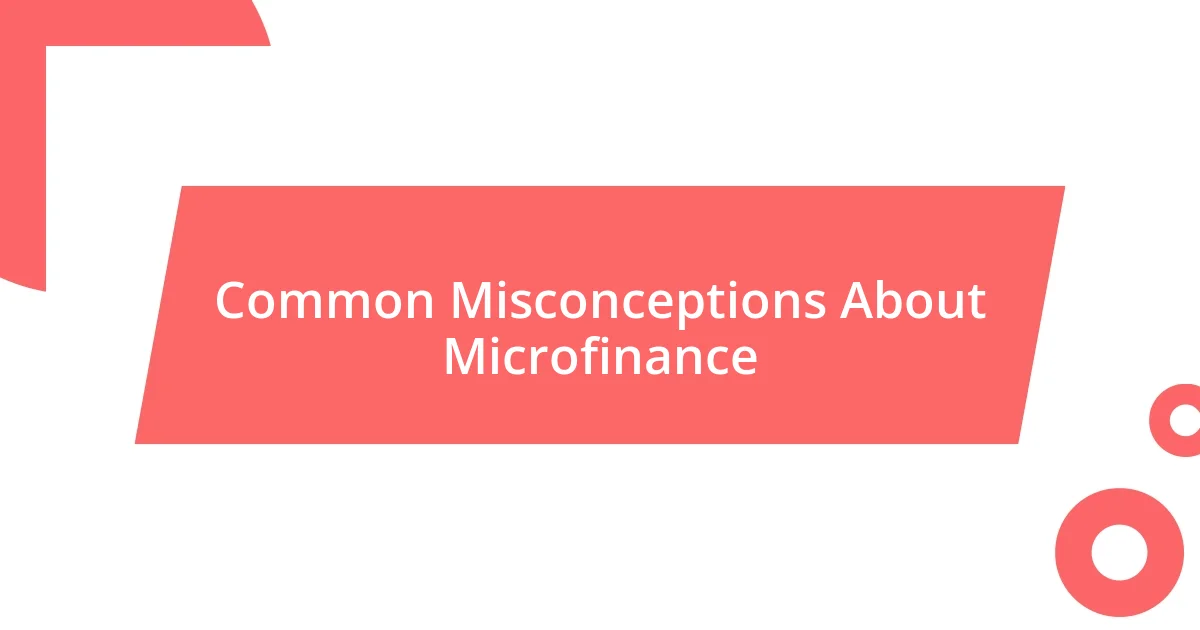
Common Misconceptions About Microfinance
There are several misconceptions surrounding microfinance that can overshadow its true purpose. One prevalent myth is that microloans are always a bad idea, leading to overwhelming debt. While it’s true that some borrowers may struggle, I’ve observed that many clients successfully manage their loans when paired with appropriate financial education and support. I remember chatting with a young entrepreneur named Samir, who shared how he diligently planned his repayments while growing his mobile food stall business. For him, the microloan was a stepping stone, not a burden.
Another common misunderstanding is that microfinance is solely for women. While studies show that women are often the primary beneficiaries due to gender-specific barriers in access to resources, men also utilize these services effectively. I’ve met plenty of male entrepreneurs who have benefitted immensely from microfinance programs. Take Javier, for example, who secured funding to expand his auto repair shop. His success story reinforces that microfinance serves anyone committed to improving their livelihoods, regardless of gender.
Finally, people often think that microfinance institutions are purely charitable organizations. In reality, many operate on a sustainable business model that includes interest rates and loan repayments. This is crucial for their ongoing viability and ability to serve the community. I once visited a microfinance institution where the staff emphasized their commitment to balancing social impact with financial sustainability. They understood that by running a responsible business, they could continue helping people like Ana, who used her microloan to open a bakery that supported her entire family.
| Misconception | Reality |
|---|---|
| Microloans lead to debt traps | Many borrowers, with proper education, manage loans successfully. |
| Microfinance is only for women | Both men and women benefit; it supports anyone determined to improve their lives. |
| Microfinance is purely charitable | Many institutions operate sustainably, balancing social goals with financial health. |
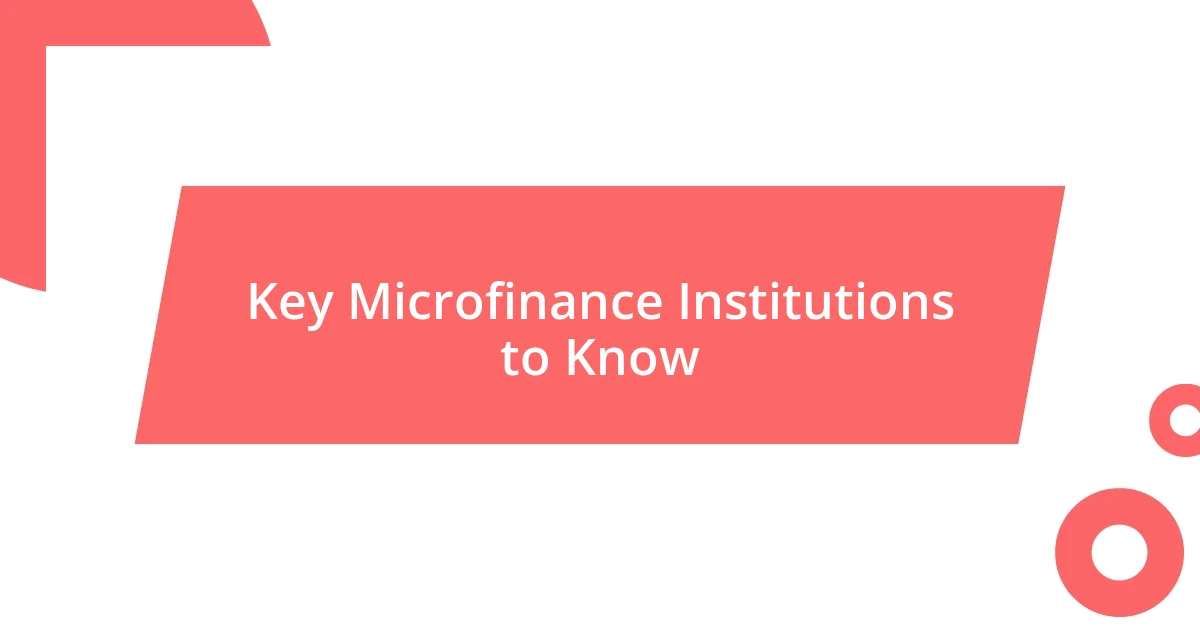
Key Microfinance Institutions to Know
One key player in the microfinance landscape is Grameen Bank, founded by Muhammad Yunus in Bangladesh. I remember learning about how Yunus started by giving tiny loans to local women struggling to support their families. The incredible success of this model has led to a global movement, inspiring countless other institutions aiming to empower the marginalized. Isn’t it fascinating how a simple idea can ripple out to create change across the world?
Another significant institution is Kiva, which operates differently by connecting lenders directly with borrowers through a crowdfunding platform. I had the chance to explore Kiva’s website where individuals can fund projects, ranging from farmer’s needs to artisans’ materials. This creates a sense of community among lenders, as they contribute to real lives. It’s heartwarming to think that even a small amount can help someone achieve their dreams, isn’t it?
Finally, there’s Accion, which works closely with microbusinesses in various countries. My experience in attending one of their training sessions revealed how they not only provide loans but also vital business training. Participants expressed their newfound confidence in managing finances, which brought tears to my eyes as I witnessed the transformation. For many, it’s not just about getting a loan; it’s about gaining the knowledge to sustainably grow their ambitions, which is truly inspirational.
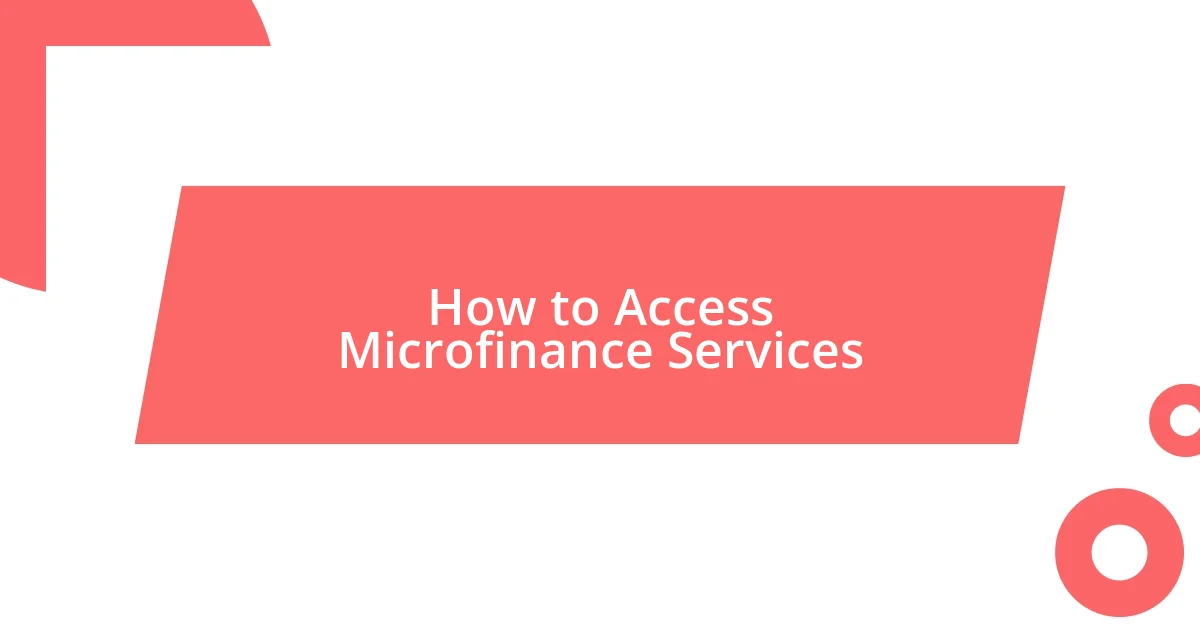
How to Access Microfinance Services
Accessing microfinance services can feel overwhelming at first, but it’s more straightforward than you might think. Start by researching local microfinance institutions (MFIs) in your area or globally, like Grameen Bank or Kiva. I remember my excitement when I discovered a local MFI that aligned with my values. It felt like finding a hidden gem that could help nurture dreams.
Once you identify potential institutions, check their eligibility criteria for loans. Each MFI has its unique requirements, often focusing on small business plans or community projects. I’ve met entrepreneurs who were initially daunted by the paperwork but realized that a simple business plan and proof of community impact were often enough to get started. Have you ever felt intimidated by a process only to find it manageable after breaking it down?
After applying, communication is key. I advise keeping an open line with the institution; they often provide guidance and support throughout your journey. When I collaborated with a small business owner seeking funding, I saw how staying in touch with the MFI helped her navigate the process smoothly. The experience highlighted that microfinance isn’t just about the money but also about building relationships and fostering trust.
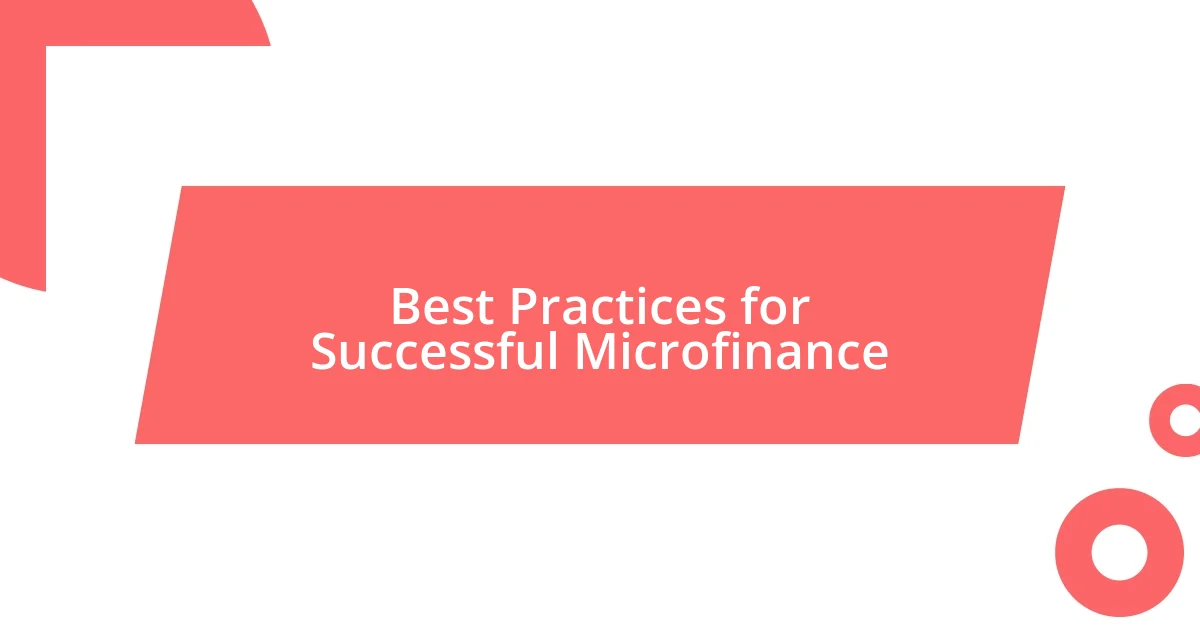
Best Practices for Successful Microfinance
In successful microfinance, understanding the community’s needs is paramount. I recall a local microfinance initiative I supported that emphasized engaging with potential borrowers before offering loans. They organized community gatherings where people could share their experiences and aspirations. This approach not only built trust but also ensured that the loans were tailored to genuine needs, making all the difference in their success.
Another best practice is providing comprehensive support beyond just financial assistance. I once met a woman who had received a loan from a microfinance institution, but what set it apart was the mentorship she received alongside it. Her mentor helped her refine her business strategy, allowing her to double her income within a year. It made me realize that when institutions invest in people holistically, they empower them to truly thrive, creating a ripple effect in the community.
Lastly, fostering a culture of transparency can’t be overlooked. I’ve seen the impact firsthand when clients are educated about the lending process, interest rates, and repayment plans. During a workshop I attended, many participants expressed relief upon understanding how their repayments would be structured, which alleviated previous fears. This clarity not only builds trust but also empowers clients to make informed decisions, which is crucial for their long-term success. Don’t you think a transparent approach could transform how we view borrowing?
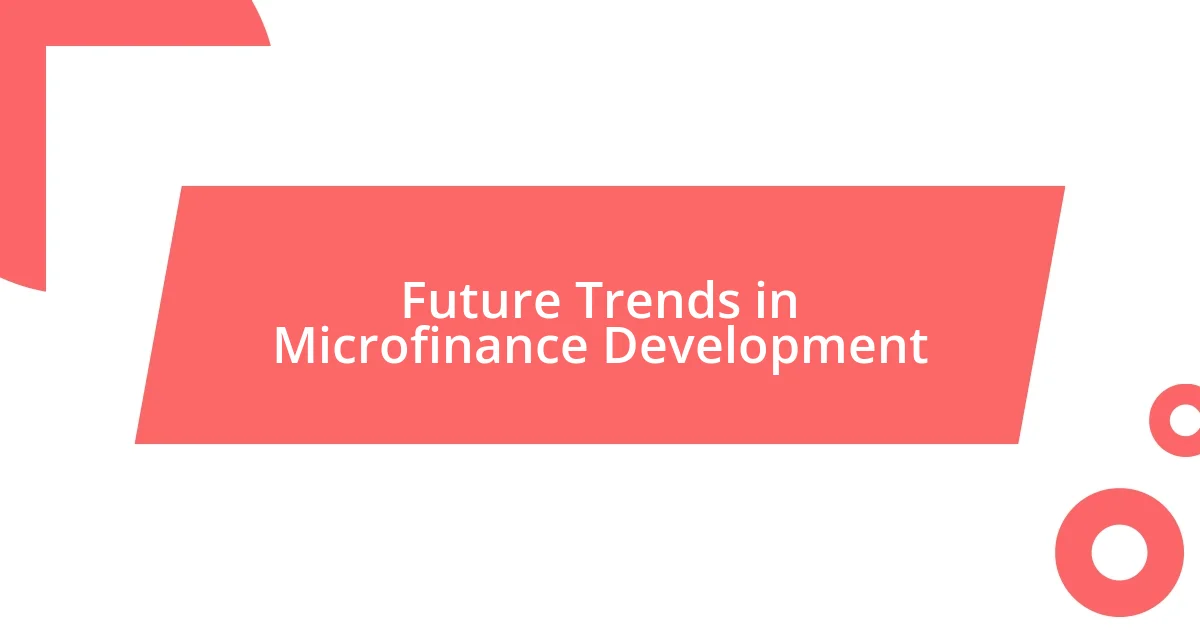
Future Trends in Microfinance Development
As we look ahead, one trend that excites me is the rise of technology-driven microfinance solutions. I’ve witnessed how mobile banking apps empower individuals in remote areas to access funds, creating a bridge to financial inclusion. It’s astonishing to think about how technology can democratize finance – just imagine being able to apply for a loan with a few taps on your phone!
Moreover, there’s a growing emphasis on social impact metrics in microfinance. I remember when I attended a panel discussion where experts debated how measuring success goes beyond just the numbers; it’s about the transformative change in a community’s well-being. This shift encourages microfinance institutions to focus on long-term relationships and sustainable growth, which is something I believe will reshape the industry.
Finally, the integration of ESG (Environmental, Social, and Governance) principles into microfinance is something I find particularly promising. It’s inspiring to see institutions seeking not only financial returns but also striving to make a positive impact on society and the planet. Thinking back to a green microfinance project I observed, it wasn’t just a financial transaction – it was about fostering sustainable practices that can benefit future generations. Isn’t it refreshing to envision an industry that aligns profit with purpose?












